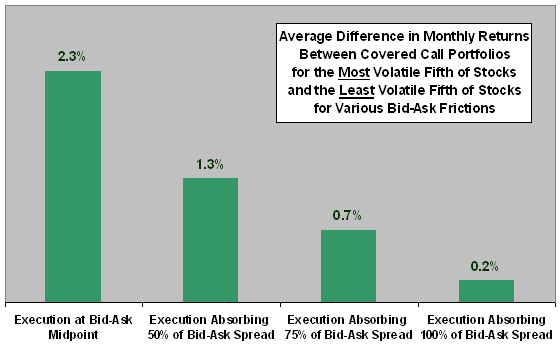On what kind of stocks can covered call writers obtain the best returns? In their July 2009 paper entitled “Cross-Section of Stock Option Returns and Individual Stock Volatility Risk”, Jie Cao and Bing Han investigate how delta-hedged stock option returns vary with volatility risk. They measure this return as the change in value of a self-financing portfolio that is long the call and short the underlying stock, rebalanced daily so that it is not sensitive to stock price movement. They assume trade execution at the mid-point of closing bid and ask quotes. Using returns for about 160,000 at-the-money delta-hedged option positions initially about one and half months from maturity (and held to maturity) for over 5,000 underlying stocks during 1996-2006, they conclude that:
- On average, delta-hedged option returns are significantly negative, and they decrease systematically with both total and idiosyncratic volatilities of the underlying stock. For example, held to maturity, delta-hedged call option positions lose on average 0.49% (4.32%) of the initial stock (call option) value.
- Writing covered calls on high-volatility stocks earns on average about 2% more per month than selling covered calls on low-volatility stocks. This spread is significantly higher for small firms, low-priced and illiquid stocks and for options with high bid-ask spreads.
- In addition, returns from writing covered calls are:
- Higher for past winner stocks than past loser stocks.
- Decrease with option open interest.
- Increase with the difference between realized volatility and at-the-money implied volatility.
- Assuming effective option bid-ask spreads of 50%, 75% and 100% of the quoted spread reduces the average difference in monthly returns between covered calls on high versus low volatility stocks from 2.33% under study assumptions to 1.25%, 0.73% and 0.22% respectively (see the chart below). The 0.22% average monthly return is not statistically reliable. In other words, only traders who can achieve relatively low options market trading frictions (such as option market makers) can reliably capture the extra volatility risk premium for high-volatility stocks.
The following chart, constructed from data in the paper, summarizes the sensitivity of differential volatility risk premium capture via covered calls to trading friction. As the trading friction approaches 100% of the bid-ask spread, the advantage of focusing on high-volatility stocks disappears.

In summary, evidence suggests that covered call writers who can achieve relatively low trading frictions can maximize returns by focusing on small, high-volatility, illiquid past winners. For small players, achieving low trading frictions is problematic.